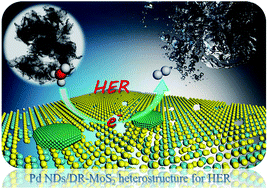Decoration of the inert basal plane of defect-rich MoS2 with Pd atoms for achieving Pt-similar HER activity†
Abstract
Outstanding hydrogen evolution reaction (HER) activity and stability are highly desired for transition metal dichalcogenide (TMD)-based catalysts as Pt substitutes. Here, we theoretically calculated and experimentally showed that adsorbing Pd atoms on the basal plane of defect-rich (DR) MoS2 will effectively modulate the surface electronic state of MoS2 while retaining its active sites, which greatly enhanced the HER activity. Three decoration strategies were used to implement this design: direct epitaxial growth, assembling spherical nanoparticles and assembling Pd nanodisks (NDs). The results showed that only Pd NDs are able to be site-specifically decorated on the basal plane of DR-MoS2 through lamellar-counterpart-induced van der Waals pre-combination and covalent bonding. This Pd ND/DR-MoS2 heterostructure exhibits exceptional Pt-similar HER properties with a low onset-overpotential (40 mV), small Tafel slope (41 mV dec−1), extremely high exchange current density (426.58 μA cm−2) and robust HER durability. These results demonstrate a novel modification strategy by a lamellar metallic nanostructure for designing excellent layered TMD-based HER catalysts.



 Please wait while we load your content...
Please wait while we load your content...